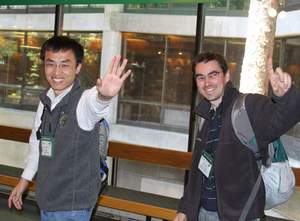Mathematics Research Communities - 2011
"The talks and group work exercises were informative and helpful. The accommodations and setting were first-rate. Mostly, though, the people who participated in this workshop--the organizers as well as the participants--made it so wonderful. For that week in June, we truly were a mathematics research community in the best sense."

Photo by Mikael Vejdemo Johansson. |

Photo by Mikael Vejdemo Johansson. |
The 2011 Mathematics Research Communities (MRC) summer conferences were held at the Snowbird Resort in Utah, June 12-July 2. The week-long conferences drew 120 early-career mathematicians. These conferences, funded by the National Science Foundation, are part of the AMS program that will include special sessions at the Joint Mathematics Meetings, a longitudinal study, and a continuation of the connections and collaborations via an electronic network.
More comments from participants:
"It was empowering and created a more lasting learning experience because participants created their own knowledge based on the well-organized background, building blocks, and current research ideas presented by the conference organizers. Great conference!"
"The colloquial setting and the student-centric level of the talks set this apart from other conferences for me. Both are something I really enjoyed."
"The emphasis on group work made the MRC conference stand out."
"The atmosphere was more informal, an atmosphere of learning instead of an atmosphere of presenting results. It was about learning the ideas, not what the presenters proved."
"There was a lot more hands-on experience which made more stimulating and made me feel more engaged with the mathematics."
"What distinguishes this conference from other conferences I have attended is that in the MRC conference I did more mathematics (as opposed to just listening to talks)."
This year's conferences:
The Geometry of Real Projective Structures
June 12 – 18, 2011
Organizers: Virginie Charette, Université de Sherbrooke; Daryl Cooper, University of California, Santa Barbara; William Goldman, University of Maryland; Anna Wienhard, Princeton University
A real-projective structure on a manifold is defined by a system of local coordinates modeled on projective space. Such structures abound in dimensions 2 and 3, and include many familiar geometries, such as spherical geometry, Euclidean geometry, and hyperbolic geometry. The space of such geometries on a fixed topology carries many interesting geometries of its own. This vastly extends the Fricke-Teichmueller space of geometric structures modeled on hyperbolic geometry.
The study of such structures intimately relates to many other fields of mathematics: Lie groups and their discrete subgroups, dynamical systems, geometric PDEs, low-dimensional topology, algebraic geometry, number theory and mathematical physics. The concrete nature of the subject invites computer experimentation. Through the experimental component of the MRC activity, participants developed and used software to visualize and calculate these geometric structures.
Computational and Applied Topology
June 19 - 25, 2011
Organizers: Gunnar Carlsson, Stanford University; Robert Ghrist, University of Pennsylvania; Benjamin Mann, Ayasdi, Inc.
One of the exciting recent developments in applied mathematics has been the explosion of insights, techniques, and tools from algebraic topology that have been used to great advantage in examining computation problems in data analysis, distributed networks, and dynamical systems. This workshop introduced participants to the theory, applications, and main advances in this emerging field, which unites theory and applications in Topology with some of Poincare's original motivation.
The Pretentious View of Analytic Number Theory
June 26 – July 2, 2011
Organizers: Andrew Granville, Université de Montréal; Dimitris Koukoulopoulos, Université de Montréal; Youness Lamzouri, University of Illinois at Urbana-Champaign; Kannan Soundararajan, Stanford University; Frank Thorne, Stanford University
Since Riemann's 1859 monograph, the study of the distribution of prime numbers has been dominated by the study of the zeros of the Riemann zeta function and Dirichlet L-functions. Although there have been ad hoc elementary proofs of some of the key results, there has been no coherent alternative approach to that of Riemann. This research community studied a new and different way to develop analytic number theory, without zeros, stemming from the concept of "pretentiousness".
The American Mathematical Society's Mathematics Research Communities program builds social and collaborative networks to inspire and sustain mathematicians who are just beginning their research careers—those who are close to finishing their doctorates or have recently finished. The structured program engages and guides all participants as they start their careers. The program includes:
* One-week summer conference for each topic (participants arrive on Sunday and depart the following Saturday; sessions are held Monday through Friday)
* Special Sessions at the national meeting
* Discussion networks by research topic
* Longitudinal study of early career mathematicians
Those accepted into this program receive support for the summer conference, and will be partially supported for their participation in the Joint Mathematics Meetings which follow in January 2012. The summer conferences of the MRC are held in the breathtaking mountain setting of the Snowbird Resort, Utah, where participants can enjoy the natural beauty and a collegial atmosphere. This program is supported by a grant from the National Science Foundation.
"Unlike any other conference ever attended, there was a much stronger feeling of community and I had far more interaction with other participants. This seems to be due to two important factors. 1) We are almost all in roughly the same stage of our careers, which brings a certain comfort level to initiating collaboration. 2) We ate together at every meal, slept in the same building, and attended a single stream of talks, all of which created a great number of opportunities for social interaction."
"I thought it was a great opportunity to meet people with similar interests. I've made a few new friends that I will stay in contact with. That's the most valuable outcome of the conference for me."
Read about the 2010 Mathematics Research Communities and the MRC program.
See information on the 2012 MRC sessions and how to apply.
Photos not credited were taken by Peter Smith (AMS Meetings) and Ellen Maycock (AMS Associate Executive Director, Meetings and Professional Services).
--- Annette Emerson, AMS Public Awareness Officer






